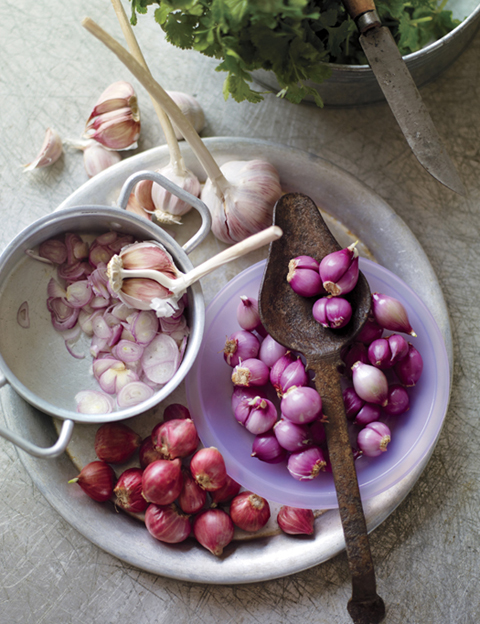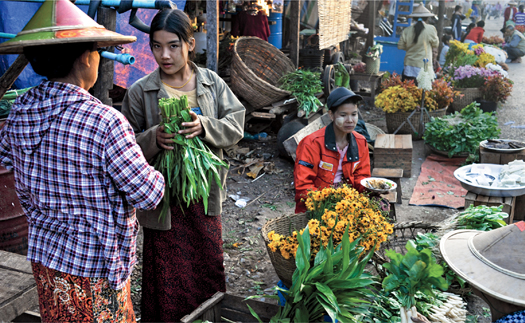

Asian shallots whole, peeled, and sliced; and garlic, with a bunch of fresh coriander behind. Shallots are the essential basic flavoring in many Burmese dishes.
COOKS ALL OVER BURMA WORK WITH LOCALLY GROWN ingredients and generally prepare dishes from scratch. As a result, flavors are fresh and food is seasonal. The basic pantry includes fried shallots and shallot oil; dried red chiles, both whole and powdered; turmeric; roasted chickpea flour; dried shrimp ground to a coarse powder; and fermented shrimp paste, as well as fish sauce. Most of these keep well, so they can be bought or prepared ahead and stored in the cupboard. Burma Basics sets out the easy fundamentals and techniques of the Burmese kitchen, in order to help you get started.
Salads in Burma are spectacular, one of the glories of the cuisine. They are made of raw or briefly cooked vegetables, or acidic fruits such as green mango and pomelo, or cooked seafood or meat. Ingredients are finely chopped or shredded, then dressed with flavorings and carefully and thoroughly blended together. Lime juice, chopped roasted peanuts, toasted chickpea flour, fried shallots, shallot oil, and fresh herbs, in enticing combinations, bring the salad ingredients to life.
Soups play a big role in Burma. Soup is an essential part of the central Burmese rice meal, often a slightly tart clear broth that is a refreshing contrast to rich curries and is sipped throughout the meal. Outside central Burma soups often include meat and vegetables. Other soups are made of chickpeas or other legumes.
“Curry,” the Anglo-colonial word that refers to dishes of meat or vegetables (or a combination) that are simmered in a sauce, is still used on English-language menus and in conversation in Burma. Central Burmese curries are generally made of meat, fish, or vegetables cooked in plenty of oil with simple flavorings: sliced shallots and turmeric, sometimes garlic, a little chile pepper (usually in powdered, dried form), and possibly ginger. Kachin and Shan curries use more fresh herbs. Most curries are mildly hot compared with those in neighboring Thailand.
Vegetables play a vital role in the Burmese kitchen. Main meals usually include a plate of raw or steamed vegetables, or a combination, to balance richer fare. One or more vegetable dishes, such as the curries and stir-fries in Mostly Vegetables, will also be served. Vegetable dishes are often flavored with a little meat, fish, or dried shrimp.
Although chicken and meat have a place at the table, apart from vegetables the most common dishes are fish- and seafood-based. Ocean fish are of course wonderfully fresh in coastal towns and villages, from Sittwe all the way south to Dawei (formerly called Tavoy), but for most Burmese, freshwater fish are the most appreciated. Dried shrimp and dried fish are staples, used as flavorings. In the Fish and Seafood chapter, you’ll find recipes for crispy fried anchovies and a festive whole fish, as well as an array of fish curries. You’ll also find fish in the Salads and Noodles chapters.
Shan meat dishes often include lots of vegetables (and, by the same token, Shan vegetable dishes may be flavored with a little meat), while central Burmese chicken and meat curries don’t include many vegetables. Generally in a rice meal there will be only one or two meat dishes among many others, so that the proportion of meat served is not high. Although some Buddhists in Burma avoid beef, and others steer clear of pork, both meats are part of the cook’s general repertoire. The Chicken chapter features several takes on chicken curry and fried chicken, as well as a succulent steamed Kachin chicken curry. In the Beef and Pork chapter, you’ll find mouthwatering central Burmese and Shan curries, an unusual Kachin spiced pounded beef, and Shan recipes for meatballs and for spiced jerky.
Whenever outsiders eat Burmese food, the wide array of condiments and sauces that are on the table is a source of wonder and pleasure. Some are punchy with chile and garlic, others milder; some are tart with tamarind, others sweeter. Condiments and Sauces presents many options that can add pizzazz to any dish, along with palate-freshening chutneys, which often accompany a simple home-cooked meal.
The literal translation of the Burmese words for “to eat”—thamin sa—is “to eat rice.” In other words, rice is embedded in daily life (see Rice Meals). In most of the country, the staple rice is similar to Thai jasmine, a slightly clinging tender white rice. The number one rice in Burma is called nyi nyi thaw. In the eastern part of Shan State sticky rice is the staple for the Tai Koen people. Mostly Rice includes recipes for breakfast favorites, including Fried Rice with Shallots and an oven-baked tender flatbread, as well as two fascinating versions of rice crepe.
Noodles are another daily essential, often served in a meat or fish broth and accompanied by a choice of condiments. Mohinga is a Burmese specialty, a cross between soup and stew made with fine rice noodles; I provide two versions, but there are many regional variations of this touchstone dish. Egg noodles, elastic and a little chewy, are the base of ohn-no khaut swe, a much-loved noodle dish dressed with a coconut sauce. From the Tenasserim coast comes a satisfying rice noodle–seafood stir-fry.
Sweet Treats has an assortment of delicious, inventive dishes, from fried bananas to semolina cake. In Burma they are usually eaten between meals, as a sweet snack with tea or coffee. They also work beautifully as a dessert at a Western table.
There’s no need for any special equipment to cook dishes from Burma. Although you would find a stone mortar and pestle useful, and a pleasure (see “Tools,”), it’s not necessary: a food processor or a knife works fine. The food processor is great for grinding dried shrimp to a powder, and for chopping roasted peanuts. I often use a spider, a mesh basket that’s like a small colander with a long handle (see photograph, this page), to lift food out of hot oil, but you can also use a slotted spoon or tongs. A wok is ideal for stir-frying; I also use mine for deep-frying because its size makes it nice and stable on the burner. You can get by with a large heavy skillet and a heavy pot for recipes that ask you to stir-fry or to slow-cook. And you can deep-fry in a deep-fryer or a wide heavy pot.
For cooking plain rice, I use a straight-sided pot with a tight-fitting lid; you can also use a rice cooker. Sticky (glutinous) rice is cooked in a steamer.
It’s helpful to have a cleaver for chopping up chicken and fish, but you can ask your butcher or fishmonger to do it for you. Chicken shears are another option for cutting up whole birds.
BURMESE FOOD IN A WESTERN CONTEXT
I’m assuming that as you embark on making dishes from Burma, you’ll be incorporating them into your cooking gradually. I’ve made serving portions larger than they would be in a multidish Burmese rice meal, where so many dishes come to the table at once. The serving suggestions in the recipes are open-ended, rather than tied to a Burmese style of meal planning. For example, many of the salads and vegetables fit happily into a Western meal, and a lot of the main dishes can be served with Mediterranean or other non-Burmese sides.
Here are some recipes for different occasions for you to choose from. Those who are inspired to make a complete rice meal.

The market in Hpa’an, in Karen State, is one of the most colorful in Burma, with women in painted and colored hats and a huge array of produce as well as flowers and prepared foods.
WEEKNIGHT SUPPER COMBOS
Perfumed Coconut Rice WITH Broccoli Rabe with a Hint of Pork
Lemongrass-Ginger Sliders WITH Long-Bean Salad with Roasted Peanuts
Fish with Tart Greens WITH Eggplant Delight
Kachin Rice Powder Soup with Chicken and Ginger WITH Traveler’s Eggplant Curry
Village Boys’ Chicken WITH Everyday Cabbage-Shallot Refresher
FOR LOVERS OF INTENSE FLAVORS
FOR THOSE WHO LIKE MILD
FOR MEAT LOVERS
FOR VEGETARIANS
BREAKFAST AND BRUNCH COMBOS
Easy Coriander-Tomato Omelet WITH Tender Greens Salad with Crispy Fried Shallots
Golden Egg Curry WITH plain rice AND Shallot Chutney with Cucumber
Breakfast Rice and Peas WITH a fried egg on top AND Sour-Plum Chutney with Chile Oil
Peanut and Rice Porridge WITH Intensely Green Spinach and Tomato Salad with Peanuts AND Fresh Red Chile Chutney
Mandalay Noodles with Chicken Curry, broth, and accompaniments
APPETIZERS AND COCKTAIL SNACKS
Shrimp Salad, served in lettuce cups
Deep-Fried Shan Tofu WITH Tamarind Sauce
Deep-Fried Street-Stall Chicken WITH Tart-Sweet Chile-Garlic Sauce
Rice Cracker Snacks WITH Kachin Salsa OR Fresh Red Chile Chutney
ON A HOT SUMMER DAY
Fish Soup with Lemongrass and Chiles
Salads of all kinds
ON A COLD WINTER EVENING
Minced Chicken with Galangal and Tomato
Simplest Beef Curry with Whole Shallots
Warming Beef Curry with Tomato
NEW TECHNIQUES FOR ADVENTUROUS COOKS